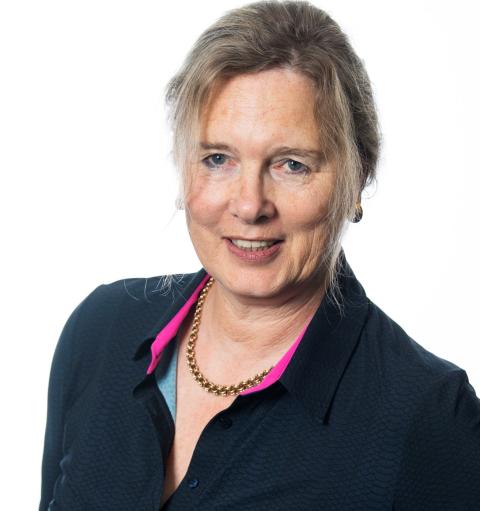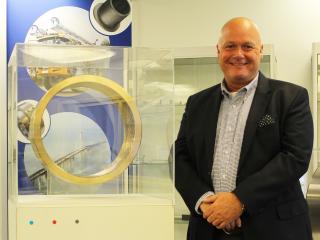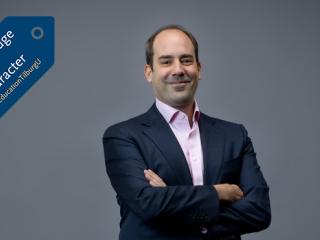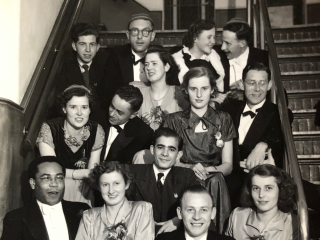Time to reflect for External PhD student Nanny Kuijsters-Timmers
Alumna Nanny Kuijsters-Timmers (58) is a lecturer at the Academy of Economics and Marketing of Fontys University of applied sciences. This year, she is hoping to obtain a doctorate on research into the significance of virtual communities in organized sports. It is her ardent wish that the official finish to her PhD project will be after the corona lockdown has ended. “While a virtual defense ceremony would certainly be a fitting match for my research topic, I do hope my colleagues, family, and friends can attend in the flesh. A PhD defense ceremony is only truly special when it is a real-life event.”
Having completed her journalism studies, Kuijsters in 1985 started her degree program in Language and Literature Science (today called Communication and Information Sciences). “In those years, campus consisted of four buildings: A, B, S, and P. My lecturers had their offices in the old barracks facing S and P. I was fortunate to be able to take most of my classes in the beautiful Cobbenhagen building.” A note to our younger readers: A and B are now Cobbenhagen and Koopmans respectively. S and P are now jointly called Prisma. She has fond memories of her time as a student at Tilburg University. “The atmosphere was open, involved, and committed to development.” She was a student-assistant to Gisela Redeker and served on the editorial board of Univers, which at the time was published every week. “Tilburg University really feels like my Alma Mater. That is one reason why I’m doing my PhD project here.”
Things started coming together
Lecturer and PhD student
Following her graduation in 1989, Kuijsters started her career as an account manager at a communications consultancy and subsequently became a marketing communication manager at a publisher whose portfolio includes daily newspapers. She pursued this career until 2005. “Meanwhile my aspiration to switch to teaching was becoming stronger.” She was a guest lecturer in Tilburg at the Theresia lyceum and at De Rooi Pannen (senior secondary vocational education, mbo), and at the invitation of Fontys University of applied sciences she started subbing as a lecturer for the SPECO Sports Marketing and Management degree program. “In the meantime, I had obtained my grade-one teaching qualification and was given tenure in 2007.” It is in that period that universities of applied sciences started doing more research. She thinks that is a good development. “Things started coming together for me then. For years colleagues in business and in education had been telling me they thought I had a bent for analysis and that PhD research would be right up my alley.” So when in 2014 her managing director asked her if should we like to do just that, she didn’t have to think twice. From that moment onward, she was a PhD student as well as a lecturer and researcher.
Smart time management is crucial
Combining PhD research and a job requires sound organizational skills. Kuijsters explains: “Proper arrangements at the home front, smart time management, determination, and not being distracted by peripheral matters are crucial. I work four days a week and for four years Fontys allowed me to devote two days a week to my PhD project. My day off and many a weekend day also went into my project. And because I enjoy it so much, that is hardly an effort.”
Click with supervisors
Everyone who has worked in a particular field for a long time has often become quite good at what they do. So unlike students who start a PhD project straight after completing a Research Master’s program, Kuijsters needed to take matters into her own hands to ensure her research skills were up to par. One of the things that greatly benefited her was an online course in statistics. “Another important condition for a successful PhD project is to click with your supervisors. Halfway through I transitioned to different supervisors; that was an educational moment for me. To be able to successfully complete a PhD project, you need to click with your supervisors. And I do with John Goedee and Roger Leenders of Tilburg University. They are interested in my research topic and field of work, and they support me in my approach. I have learned a great deal from them.”
The importance of belonging
For her PhD project, Kuijsters explored, and continues to explore, online, or virtual, communities to help address the issue of how sports clubs can reverse the decline in membership. “Earlier research shows that a sense of belonging is a key factor. I have researched what that sense of belonging means, how it can be encouraged, and what role virtual communities can play.” A virtual community is an online room that is created through the use of online channels, such as social media. In a virtual community people meet regarding a particular topic. “A shared interest helps build online social connections between people, and these connections strengthen their sense of belonging.”

Young adult members want to have a say
Nanny Kuijsters-Timmers
Kuijsters’s approach to her topic is based on two trends that are relevant to organized sports. “The first trend is increasing individualization. In the old days, people joined a sports club that suited their social position, that is to say, their faith, political preference, or work. Today, that is an individual choice. If you like field hockey, that’s what you do; do you prefer judo, you go for that. But how individual members experience club life also matters.” The second trend is digitalization: printed sports club magazines have all but disappeared and such online channels as social media have taken their place. There are approximately 68 sports associations and 26,000 sports clubs in the Netherlands. “Most use social media, but they often lack a clear strategy on the use of these channels.” Kuijsters’ research focuses on the members’ sense of belonging, the role of social media, the connection with engagement in and loyalty to a club, and how online community building can be taken in hand. “It is mostly those members who experience a sense of belonging that are prepared to commit themselves to their club long-term.” She made a point of mapping the experiences of young adult members. “They account for the highest numbers of dropouts. If clubs know what this demographic values, they can fine-tune their response and possibly keep these members on board.” One of the things that matters to these young adults is the opportunity to engage in a dialog with their club. “They want to play a role and have a say. Merely being at the receiving end of information supplied by the board it not enough for them; to them, the online community is their club’s virtual meeting place.”
Prevent tunnel vision
Kuijsters’ PhD project consists of seven studies that use various methods and perspectives, such as a questionnaire, an essay survey (see box), and a literature review. She also delved into the philosophy of science. “I found myself facing such questions as ‘what are science and knowledge development?’ and ‘how can I as a researcher contribute to society?’. I was inspired by the philosophers of science Thomas Kuhn and Michel Foucault. They advocate research that views and discusses a topic from various angles; to them it is the scientific discourse that matters. I believe we can see more because of these various perspectives and prevent tunnel vision.” That is why Kuijsters uses a variety of methods as well as views from several disciplines in her research. In addition to authoring research publications and giving presentations, she publishes in professional journals and integrates the findings of her research into her course materials.
I have mixed feelings about a PhD thesis consisting of journal articles
More time for reflection
Kuijsters has mixed feelings about the world of science apparently being dominated by the need to have research published in journals. “When I started, I was expected to write a PhD thesis consisting of journal articles. As I progressed, I began to question to wisdom of that choice. For me it meant diverting too much attention to developing content that would get an article accepted for publication in a journal, for example, a study with a positive result. But it’s the research process itself and all results that matter, be they negative or positive. Knowledge that might be slightly out of place in a scientific journal article also contributes to knowledge development. And these articles only reach a small and select audience, confining the discourse to a rather small circle.” Even so, she is proud of the five scientific articles she has written, three of which have so far been published in the International Journal of Human Movement and Sports Science and the Tijdschrift voor Communicatiewetenschap (communication sciences journal). “Writing them was hard but ultimately rewarding work. My project has taken longer because I couldn’t work on it full-time, but that also meant I could take time to reflect and use the results to adjust the project as I went. My original research plan went through frequent revisions since I first handed it in at the university in 2014.”
What’s next?
While Kuijsters is ready to complete her project and defend her PhD thesis sometime this year, she will continue to further explore the topic of virtual communities at sports clubs and has secured funding for two follow-up studies.
Update: Nanny Kuijsters obtained her PhD on 21 December 2021.
Essay survey
One of Kuijsters’ substudies was an essay survey amongst students. “The survey aimed to more fully understand how clubs could approach community building. The respondents indicated that they want to meet online and discuss important topics with the board.” She observed that there are various types of communication and that the communication mode is shifting. “Young adults want to engage in dialog, not just ingest transmitted information.”
Date of publication: 19 March 2021




